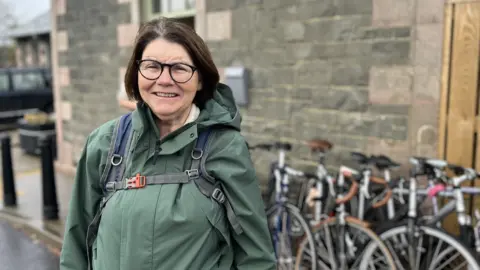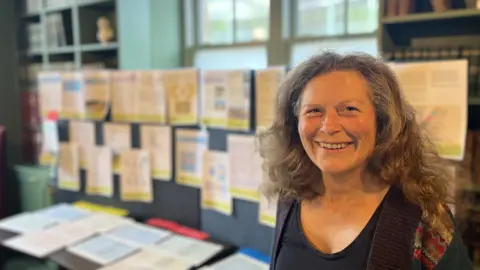How the Borders Railway revived a valley community
 BBC
BBCWhen the new Borders Railway brought trains back to a Gala Water valley in 2015, it sparked a remarkable revival.
In Stow, old rail buildings, including a former ticket office, have been converted into a bistro with adjoining office space and a meeting room.
A bike hub was also created to help promote cycling in the valley.
And now there are plans to generate its own power supply, create new jobs and housing, and even celebrate its Pagan and witchcraft heritage.
Grace Murray, from Stow Community Trust, said: "We are trying to make the valley an even greater place to live and visit."
Following the closure of the Waverley Line in 1969, the fortunes of Stow, Heriot and Fountainhall in the Gala Water valley began to wane.
Industry and retail within the villages suffered, and changes to farming led to even less employment.
The successful fight for a railway station during the planning of the Borders Railway led to a community group taking over the former ticket office, waiting room and station master's house next to the new platform.
 Adrian Taylor
Adrian TaylorThe first trains arrived in Stow in 2015, on the new route between Edinburgh and Tweedbank in the Scottish Borders.
Just four years later, the village's Community Trust had fully converted the 150-year-old building into a cafe, office and meeting space.
A bike hub was added in the following months.
Ms Murray, who chairs the community trust, believes the success of the Station House development gave the community the confidence to forge ahead with even more ambitious plans.
She said: "We fought hard to keep the Station House when the plans were being developed for the railway coming back to the village.
"It's now a spectacular and well-used building - and the project gave all of us the confidence to pull together this action plan for what else we can do to improve the valley."
Work on a new pump track is due to begin early in the new year.

Extended cycling and walking trails are also in the pipeline, with 50 locals already signed up to an e-bike membership scheme.
Eibhlin McHugh from Stow Community Trust has been heavily involved in the development of the new bike hub since the return of the railway.
She said: "Promoting cycling was always in our early plans and we're continually developing and responding to need.
"If you are a driver you just go up and down the A7 through the valley, but cycling takes you around all of the small communities.
"We have new people coming here to the bike hub all the time to cycle in and around the Gala Water Valley."
Although the population of the Gala Water Valley is a little over 2,200, the Community Trust's survey for preparing an action plan attracted about 4,000 written responses.
Many projects highlighted in the published document are already being implemented - such as the creation of wildflower meadows, new social media pages and the formation of an environmental group.
Car share schemes, shop-local campaigns, new street lighting and better recycling facilities are also being delivered.
But it's the long-term projects which show the greatest ambition.
Investigations have started for turning a Pagan well into a visitor attraction, along with a site to commemorate the so-called Stow witches who were burnt alive in the 17th Century.

Plans are also taking shape for a medieval trail to link the valley's former bishop's palace and old kirk with similar sites in neighbouring valleys.
Community power is being investigated, along with refurbishment of the parish church, a takeover of the town hall, another railway station at Fountainhall, and the creation of new social housing.
Julie Nock, from the Southern Uplands Partnership, is behind the Stow and Fountainhall community action plan.
She said: "The people of this valley are really forward-thinking.
"So much about the Gala Water Valley is not well known, but the return of the railway and the subsequent action plan gives us an opportunity to change that.
"I didn't know anything about the Stow witches or Our Lady's Well when I started the survey, but these are clearly opportunities to not just celebrate the area's heritage, but to also attract more tourism - and by doing so, create new jobs."

Do you have an idea for a story we could cover? Email our local reporters in the Scottish Borders at [email protected]
